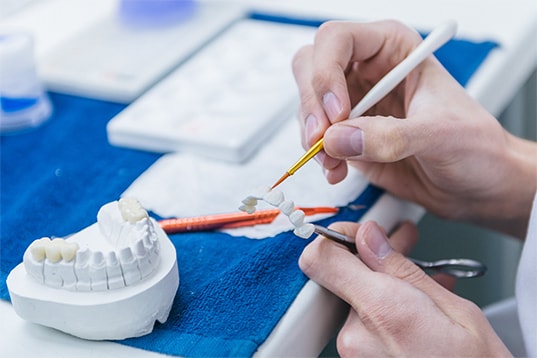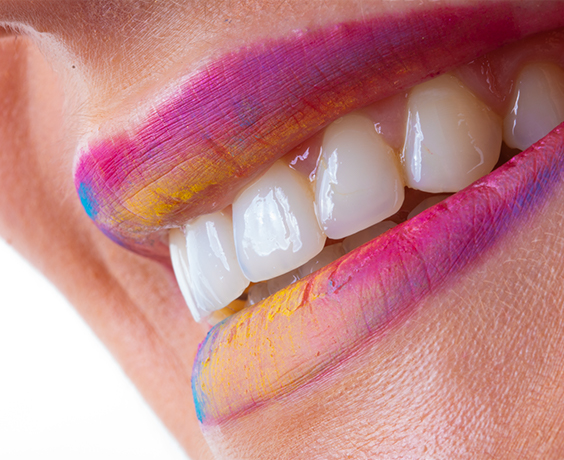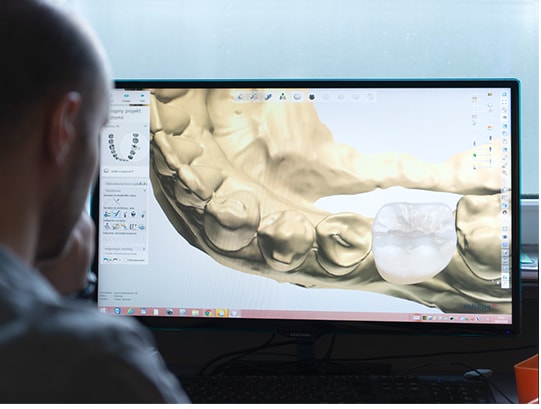

Aesthetic dentistry allows us to reshape teeth and to change patient’s facial features. We improve out patient’s bite and facial features. It is possible thanks to a complex action and thorough attitude towards treating –
maximum effect. We present a project to the patient, using a visualisation of the Digital Smile Design DSD programme, or a mock-up made in the laboratory, or – an instant method – we present it directly in the patient’s mouth.
During the treatment, we correct any small occlusal defects, imperfections in the shape of teeth and alveolar ridge (gum smile, asymmetries, etc.). We restore state of the patient’s physiology from years ago, or a good state that was never achieved before. Our work is carried out at the correct and carefully analysed vertical dimension of occlusion, characteristic for each patient. It gives us unlimited aesthetic possibilities.
The least destroyed teeth are reconstructed right away. This is the most gentle, “saving”, procedure, i.e. it does not affect the structure of the tooth. More damaged front teeth are covered with porcelain veneers and the most damaged ones with crowns; we present to the patient a wide range of these to choose from.


Porcelain veneers
Porcelain veneers are like “press-on nails”, just on teeth. They are a thin layer that covers the teeth. Porcelain veneers can perfectly improve the shape and the colour of teeth. The use of high-quality porcelain and various types of technology to produce them allows the smallest possible preparation of natural tooth tissues. Achieving the desired effect is possible thanks to detailed schedule of work and thoughtful preparation of teeth for veneers, depending on the occlusal defect or on the need to cover up the shape defect. Porcelain veneers with natural translucency, carefully selected shape and appropriate length can meet the needs of the most demanding patients.
Can I use one veneer my whole life?
Usually we make jokes, while answering this question to our patients, that porcelain that is couple thousand years old can be sometimes found intact during archaeological excavations. But seriously, veneer can be of lifelong use if a patient has a healthy periodontium and takes care of them in a specific way.
How to take care of porcelain veneers?
First of all, you have to take care of your oral hygiene and to prevent tartar build-up. A hygienic consultation every six months is definitely enough. While cleaning teeth covered with porcelain veneers, as well as while cleaning your own teeth, it is important to take care about so called gingival attachment. It means that while brushing you should “pull” the gingiva towards the teeth, instead of brutally pushing them in the other direction. A gentle gingiva massage, from the red part (gingiva) to the white part (tooth) can have amazing results.


Technology and precision
The defects in the lateral parts of the teeth are reconstructed by sculpting the anatomical shape (full of pits and cusps) right away or by making inlays and onlays (“fillings” raising the vertical dimension of occlusion, made in our prosthodontic laboratory, most often of porcelain). This method is the most precise, aesthetic and long-lasting. Porcelain inlays and onlays are highly durable and lowly abrasive, which is really important when someone has problems with occlusion.
We work on an intraoral scanner from 3-shape company, which allows us to transfer the image from the patient’s oral cavity directly to the prosthodontic laboratory, where a technician virtually designs the missing parts of a tooth, using a resource-rich library of tooth shapes or reconstructs the shape of the patient’s own scanned teeth. The work is then milled on a digital milling machine and individualised. Finished fillings are installed in the patient’s mouth within a few days.